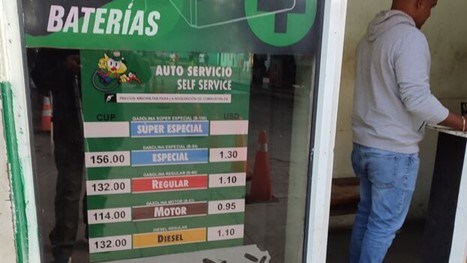
Some gas stations already display the new prices in Cuban pesos and dollars, which are now on hold.
By 14ymedio
HAVANA TIMES — In national currency and also in USD – a great novelty of the reform announced in January – the new fuel prices appeared this Wednesday on the pumps at the gas station at Rancho Boyeros and Ayestarán, in Havana. However, drivers are alarmed when they see those rates in pesos and dollars – five times more expensive than the previous ones – and the employees explain that the change will take effect tomorrow, Thursday, February 1. However, the official media reported this afternoon that the implementation of the new rates is postponed.
“The government’s projections to correct distortions and re-boost the economy during 2024 will only be implemented if the conditions for this are created,” Mildrey Granadillo de la Torre, first vice minister of Economy and Planning, told national television. “Defending this principle” it is decreed to postpone the implementation of the “price update” of gasoline, said the senior official, who added that “this decision includes the occurrence of a cybersecurity incident in the computer systems for the commercialization of fuels whose origin has been identified in a virus from abroad.”
It was also reiterated by Esther, the person in charge of organizing the queue to buy fuel in Guanabacoa via Telegram: “The update of fuel prices and its marketing in USD is extended. The decision is due to a cybersecurity attack in the marketing system of Cimex.”
The Cuban influencer Manuel Milanés alluded to this on Tuesday in a tweet from Miami: “The Cimex de Gaesa Corporation had its entire management system erased and they had no backup, they are doing a general inventory to be able to have some control.”
Asked by 14ymedio, a driver from the state-owned Copextel says that the new measure does not worry him. Premium gas is at 156 pesos or 1.30 dollars instead of 30 pesos, regular and diesel at 132 pesos or 1.10 dollars, and diesel at 114 pesos or 0.95 dollars (instead of 25 and 20 pesos, respectively), he recites, while filling the tank of his truck. “I don’t care what it costs, because the company where I work pays for it. If I don’t have the money to pay for fuel, I’ll stay home,” he adds.
Private car drivers, however, do not show the same peace of mind. After spreading the word that the service center at 25 and G, in El Vedado, would be dispatching gasoline this morning, dozens of boteros (taxi drivers) and car owners gathered in a line that stretched for several blocks on both sides of F Street.
“I’m behind that Kia and he’s behind the red Peugeot,” a driver shouted. “No one wants a mess here; that’s why everyone who gets in line takes a photo of the license plate of the car in front of him, so those behind don’t cut in with two other people,” one of the boteros tells this newspaper.
Uneasy about the change of prices, with which they predict irregularities and preference of the Government with foreign exchange services, many of those who wait at 25 and G will try to buy as much fuel as they can this Wednesday. “I already emptied the little gasoline I had in the car to be able to fill the tank to the top. I also always bring a few gallon containers in the trunk in case I can buy more,” says one of the drivers, who complains that the line isn’t moving. “My brother-in-law, who is a few cars ahead, even went to his oncology appointment at the hospital, and when he returned the line had barely moved.”
Another of his concerns, not far from reality, he says, is that the new card payment systems do not work in a country with constant power cuts and frequent drops in the electronic collection system. This same afternoon, the two gas stations in Guanabacoa warned that payment was only possible with the cards issued by Fincimex and that the QR code did not work.
Many drivers, annoyed by the delay and noon hunger, complain about the way the government is handling the price change, knowing that the demand for fuel will skyrocket. “It’s going to go on,” one said, “and the dollar keeps rising, you don’t even know where it’s going to go.”
“That guy you see there on the motorcycle,” he continued, “has been walking around the street all morning. It seems that they sent him to make sure everything is quiet. You notice them right away by the mask, the dark glasses and the cap they wear so that you don’t recognize them,” he says. “They have fuel for those guys.”
In the few hours left before the prices change, there are more incidents than usual, both in the payment systems and the suspension of service, because no technician appears to fix the supposedly damaged gas pumps.
The rest of the signs that the habaneros have learned to decipher, such as the smoke of the patana (floating Turkish power plant) anchored in the bay or the fire of the Ñico López refinery, do not give indications that oil is circulating in the city. This morning, neither of them had the chimneys lit.
Cuban ports, however, report the entry of oil tankers such as the Alicia and the Chemical Contender in Havana; the Lourdes, the Ocean Mariner and the Sandino in Matanzas; the Esperanza in Cienfuegos; and the LPG Emilia in Santiago de Cuba, where they also expect the Aquila this Wednesday.
Translated by Regina Anavy for Translating Cuba
Read more from Cuba here on Havana Times